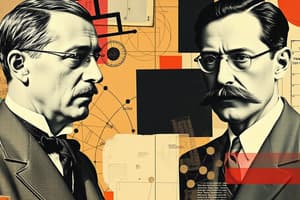Podcast
Questions and Answers
According to Taylor's theory of scientific management, how are workers selected for jobs?
According to Taylor's theory of scientific management, how are workers selected for jobs?
Workers are scientifically selected based on their suitability for the job, as determined by time and motion studies.
What is the main focus of communication within an organization according to Fayol's principle of "subordination of individual interest to general interest"?
What is the main focus of communication within an organization according to Fayol's principle of "subordination of individual interest to general interest"?
Communication should primarily focus on tasks and organizational goals rather than individual concerns.
What is the primary direction of communication flow in classical management theories?
What is the primary direction of communication flow in classical management theories?
The vertical flow of information along the organizational hierarchy is the most important route.
Explain why the written mode of communication is considered prevalent in classical management theories.
Explain why the written mode of communication is considered prevalent in classical management theories.
Describe the typical style of communication within classical organizations.
Describe the typical style of communication within classical organizations.
What is the fundamental difference between managers and workers according to Taylor's theory?
What is the fundamental difference between managers and workers according to Taylor's theory?
Why are workers discouraged from suggesting ways to improve the organization according to Taylor's theory?
Why are workers discouraged from suggesting ways to improve the organization according to Taylor's theory?
Despite being developed several decades ago, why are the classical management theories of Fayol, Weber, and Taylor still relevant today?
Despite being developed several decades ago, why are the classical management theories of Fayol, Weber, and Taylor still relevant today?
What is a key example of emotional labor in the airline industry, as described in the text?
What is a key example of emotional labor in the airline industry, as described in the text?
What is one subtle way flight attendants resist control over their emotional expression?
What is one subtle way flight attendants resist control over their emotional expression?
What does the example of the flight attendant turning the smile requirement back on a passenger demonstrate?
What does the example of the flight attendant turning the smile requirement back on a passenger demonstrate?
Describe one specific way flight attendants resist the gender hierarchy status in the airline industry.
Describe one specific way flight attendants resist the gender hierarchy status in the airline industry.
How does the airline industry control flight attendants' movement and space?
How does the airline industry control flight attendants' movement and space?
How do flight attendants resist the regulation of movement and space, even in training?
How do flight attendants resist the regulation of movement and space, even in training?
What is one way female flight attendants resist regulation of their appearance?
What is one way female flight attendants resist regulation of their appearance?
Why is the resistance of flight attendants important to understand?
Why is the resistance of flight attendants important to understand?
Explain how the concept of corporate colonization, as described by Deetz, impacts the workplace and beyond.
Explain how the concept of corporate colonization, as described by Deetz, impacts the workplace and beyond.
Provide an example of how education has been influenced by the corporate colonization model.
Provide an example of how education has been influenced by the corporate colonization model.
What does Deetz mean by the "colonization of the lifeworld"?
What does Deetz mean by the "colonization of the lifeworld"?
How do corporations contribute to the formation of individual identity in the workplace?
How do corporations contribute to the formation of individual identity in the workplace?
Describe the concept of "subversive activities" as a form of resistance to corporate control.
Describe the concept of "subversive activities" as a form of resistance to corporate control.
How do these acts of resistance demonstrate the potential for change in organizational dynamics?
How do these acts of resistance demonstrate the potential for change in organizational dynamics?
What are the ethical concerns related to corporate practices that exploit employees and distort their sense of work?
What are the ethical concerns related to corporate practices that exploit employees and distort their sense of work?
In your own words, explain why Deetz uses the term "corporate colonization" to describe the influence of corporations on society?
In your own words, explain why Deetz uses the term "corporate colonization" to describe the influence of corporations on society?
Explain how the "Information Seeking" phase of organizational socialization helps newcomers reduce uncertainty.
Explain how the "Information Seeking" phase of organizational socialization helps newcomers reduce uncertainty.
Describe the difference between high-quality and low-quality Leader-Member Exchange (LMX) relationships within the context of role development.
Describe the difference between high-quality and low-quality Leader-Member Exchange (LMX) relationships within the context of role development.
Explain what is meant by "organizational exit" and how it can impact the remaining members of an organization.
Explain what is meant by "organizational exit" and how it can impact the remaining members of an organization.
According to the "Classical Approach" to organizational socialization, what is the primary goal of the socialization process?
According to the "Classical Approach" to organizational socialization, what is the primary goal of the socialization process?
What does the "Human Relations Approach" prioritize during the organizational socialization process?
What does the "Human Relations Approach" prioritize during the organizational socialization process?
Describe the key focus of the "Human Resources Approach" to organizational socialization.
Describe the key focus of the "Human Resources Approach" to organizational socialization.
Explain how the "Systems Approach" interprets organizational socialization.
Explain how the "Systems Approach" interprets organizational socialization.
What is the primary focus of the "Cultural Approach" to organizational socialization?
What is the primary focus of the "Cultural Approach" to organizational socialization?
Describe the key advantage of an 'All-Channel Network' communication structure.
Describe the key advantage of an 'All-Channel Network' communication structure.
What is the primary concern associated with 'Information Overload' in the decision-making process?
What is the primary concern associated with 'Information Overload' in the decision-making process?
Explain how 'Filtering' can negatively impact decision-making in an organization.
Explain how 'Filtering' can negatively impact decision-making in an organization.
Identify one challenge associated with implementing participative decision-making (PDM) in an organization.
Identify one challenge associated with implementing participative decision-making (PDM) in an organization.
What is the primary benefit of implementing PDM?
What is the primary benefit of implementing PDM?
According to the classical approach to decision-making, who has the primary responsibility for decision-making?
According to the classical approach to decision-making, who has the primary responsibility for decision-making?
Describe the key difference between the human relations and human resources approaches to decision-making?
Describe the key difference between the human relations and human resources approaches to decision-making?
What is the underlying principle behind the human resources approach to decision-making?
What is the underlying principle behind the human resources approach to decision-making?
According to Cotton (1993), what is the primary goal of employee involvement?
According to Cotton (1993), what is the primary goal of employee involvement?
What does Pfeffer (1998) refer to as "putting people first" and what are the seven key practices he identifies?
What does Pfeffer (1998) refer to as "putting people first" and what are the seven key practices he identifies?
Despite the potential benefits of human resource management, why do such programs often fail in practice?
Despite the potential benefits of human resource management, why do such programs often fail in practice?
In what type of environment are team-based structures most effective?
In what type of environment are team-based structures most effective?
Why is top management commitment crucial for the success of change initiatives?
Why is top management commitment crucial for the success of change initiatives?
What is the importance of employees understanding new terminology associated with human resource programs?
What is the importance of employees understanding new terminology associated with human resource programs?
What are the two key approaches to organisational communication discussed in this chapter?
What are the two key approaches to organisational communication discussed in this chapter?
Flashcards
Scientific Management
Scientific Management
A system where scientific methods determine the best way to perform tasks.
Recruitment in Scientific Management
Recruitment in Scientific Management
Selection of workers based on scientific methods to match jobs to their skills.
Training Workers
Training Workers
Workers are trained in methods deemed most effective through studies.
Communication Content
Communication Content
Signup and view all the flashcards
Direction of Communication Flow
Direction of Communication Flow
Signup and view all the flashcards
Channel of Communication
Channel of Communication
Signup and view all the flashcards
Style of Communication
Style of Communication
Signup and view all the flashcards
Relevance of Classical Theories
Relevance of Classical Theories
Signup and view all the flashcards
Employee Involvement
Employee Involvement
Signup and view all the flashcards
Knowledge-Enabled Organisation
Knowledge-Enabled Organisation
Signup and view all the flashcards
Putting People First
Putting People First
Signup and view all the flashcards
Total Quality Management (TQM)
Total Quality Management (TQM)
Signup and view all the flashcards
Team-Based Management
Team-Based Management
Signup and view all the flashcards
Top Management Commitment
Top Management Commitment
Signup and view all the flashcards
Employee Cynicism
Employee Cynicism
Signup and view all the flashcards
Understanding New Terminology
Understanding New Terminology
Signup and view all the flashcards
Corporate Colonization
Corporate Colonization
Signup and view all the flashcards
Colonization of the Lifeworld
Colonization of the Lifeworld
Signup and view all the flashcards
Educational Corporate Model
Educational Corporate Model
Signup and view all the flashcards
Consumer Model of Education
Consumer Model of Education
Signup and view all the flashcards
Employee Autonomy
Employee Autonomy
Signup and view all the flashcards
Subversive Resistance
Subversive Resistance
Signup and view all the flashcards
Organizational Contestation
Organizational Contestation
Signup and view all the flashcards
Corporate Ideologies
Corporate Ideologies
Signup and view all the flashcards
Emotional Labor
Emotional Labor
Signup and view all the flashcards
Subtle Resistance
Subtle Resistance
Signup and view all the flashcards
Gender Hierarchy Resistance
Gender Hierarchy Resistance
Signup and view all the flashcards
Regulation of Movement
Regulation of Movement
Signup and view all the flashcards
Circumventing Surveillance
Circumventing Surveillance
Signup and view all the flashcards
Regulation of Appearance
Regulation of Appearance
Signup and view all the flashcards
Resistance to Appearance Rules
Resistance to Appearance Rules
Signup and view all the flashcards
Authority Challenge
Authority Challenge
Signup and view all the flashcards
Information Seeking
Information Seeking
Signup and view all the flashcards
Leader-Member Exchange (LMX) Theory
Leader-Member Exchange (LMX) Theory
Signup and view all the flashcards
High-Quality Exchanges
High-Quality Exchanges
Signup and view all the flashcards
Organizational Exit
Organizational Exit
Signup and view all the flashcards
Classical Approach
Classical Approach
Signup and view all the flashcards
Human Relations Approach
Human Relations Approach
Signup and view all the flashcards
Human Resources Approach
Human Resources Approach
Signup and view all the flashcards
Cultural Approach
Cultural Approach
Signup and view all the flashcards
Wheel Networks
Wheel Networks
Signup and view all the flashcards
All-Channel Networks
All-Channel Networks
Signup and view all the flashcards
Information Overload
Information Overload
Signup and view all the flashcards
Information Distortion
Information Distortion
Signup and view all the flashcards
Participative Decision-Making (PDM)
Participative Decision-Making (PDM)
Signup and view all the flashcards
Benefits of PDM
Benefits of PDM
Signup and view all the flashcards
Study Notes
No topic provided. Please provide the text or questions.
Studying That Suits You
Use AI to generate personalized quizzes and flashcards to suit your learning preferences.




